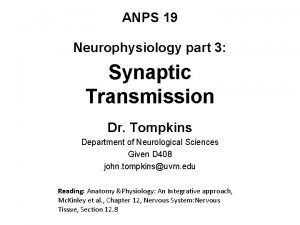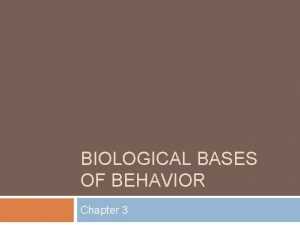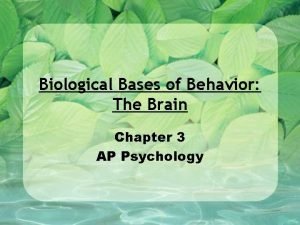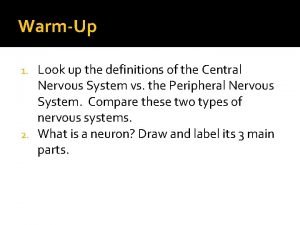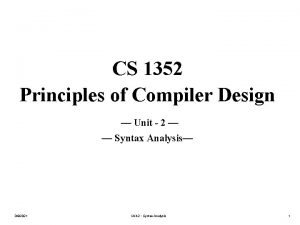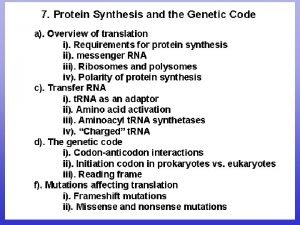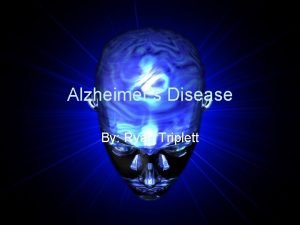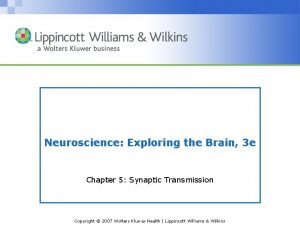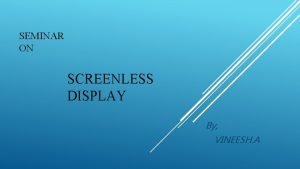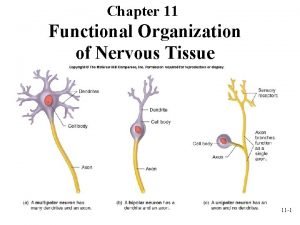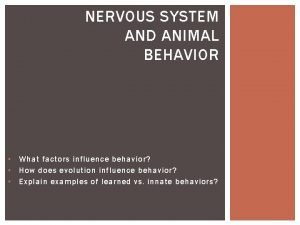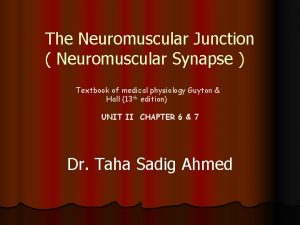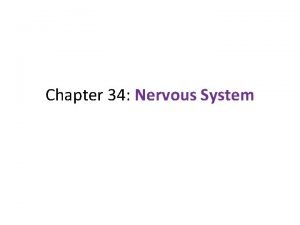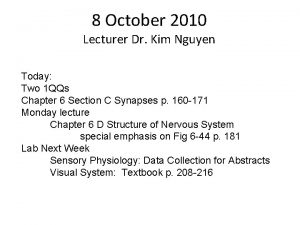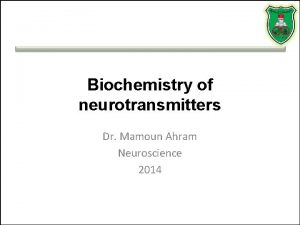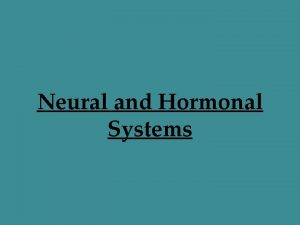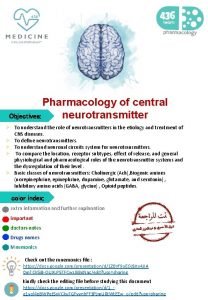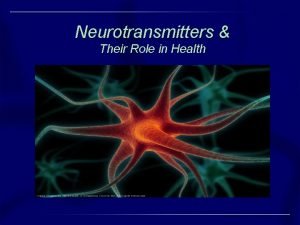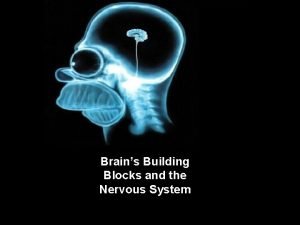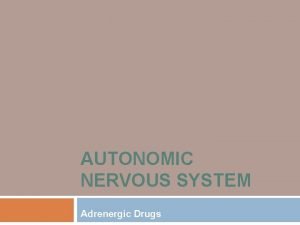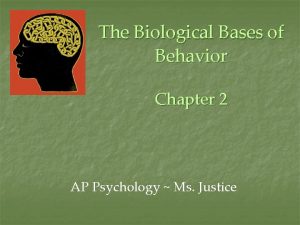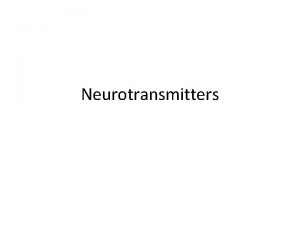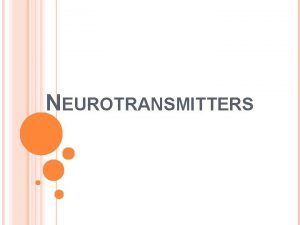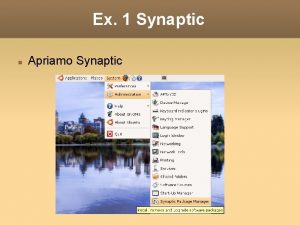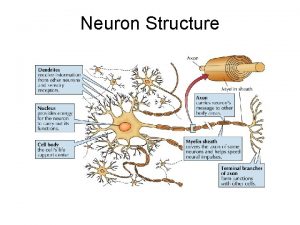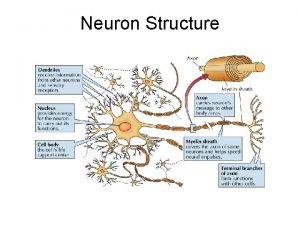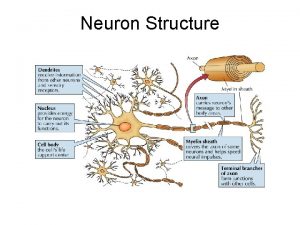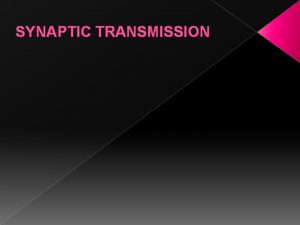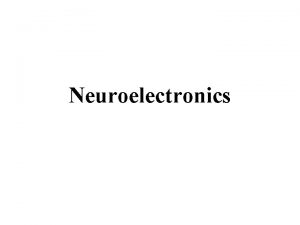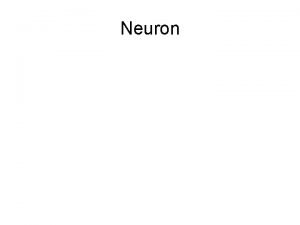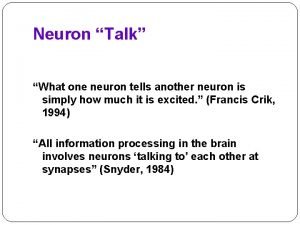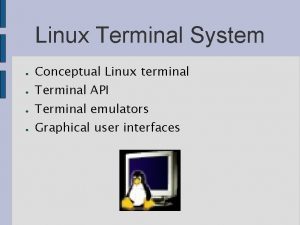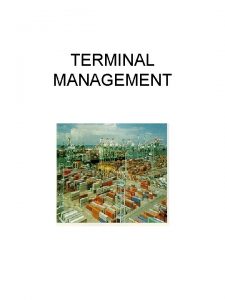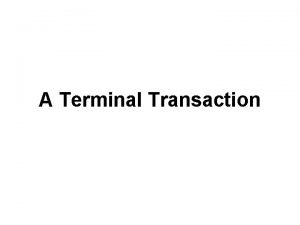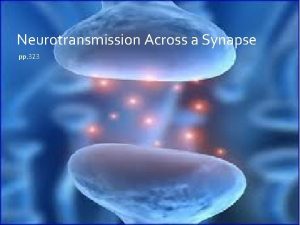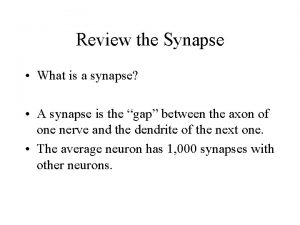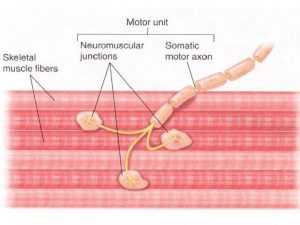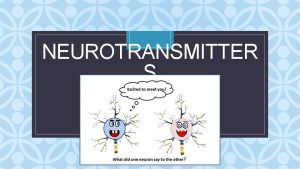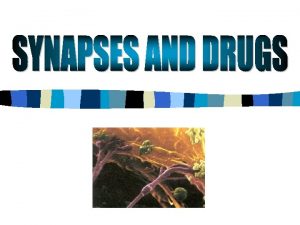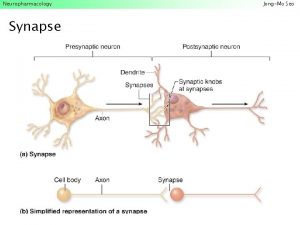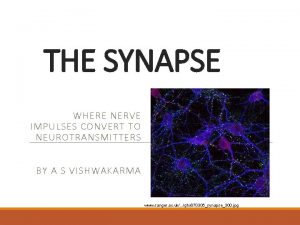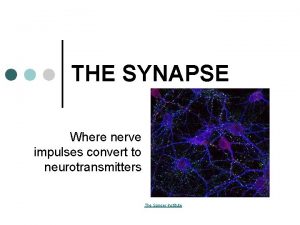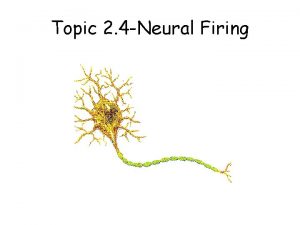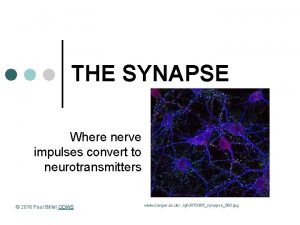Neurotransmitters Synapse Activity Neuron Terminal oval showing synaptic



























- Slides: 27

Neurotransmitters

Synapse Activity Neuron Terminal (oval) showing synaptic vesicles (black dots)

Neural Messaging

How does it fire? • Inhibitory and excitatory neurotransmitters stimulate the dendrite • Resting potential (natural resting charge) = -70 millivolts • Threshold (level of stimulation required to trigger an neural impulse) = -55 millivolts • Firing the impulse (action potential, an electrical charge) down the axon • Exchange of positive ions & negative down the axon fibers to the next neuron


• Acetylcholine (Ach) – muscle movement & memory – Lack of Ach can result in paralysis or memory loss • Dopamine – Control of bodily movements, the “feel good neurotransmitter” – Lack Parkinson’s disease Heroine and Meth both create a flood of dopamine • Endorphins – pain relief and sense of well being, released during periods of pain or intense exercise “runner’s high”

• Agonist – a neurotransmitter, or other chemical that promotes the firing of a neuron • Antagonist – a neurotransmitter or other chemical that inhibits the firing of a neuron

Acetylcholine – muscles, memory and learning Too much Too little • Seizures • Memory loss / dementia • Alzheimer’s disease • Paralysis – Black widow spider venom agonist – Botox (Botulism) - Antagonist – Curare (poison dart plant) Antagonist

Dopamine – Control of bodily movements, learning, attention, positive emotions - the “feel good neurotransmitter” Too much Too little • Schizophrenia • Depression • Parkinson’s disease

Endorphins – pain relief and sense of well being, released during periods of pain or intense exercise Too much Too little • Runners High • Pain, depression • Heroin, morphine, codeine – all mimic endorphins – can cause bodies ability to release own endorphins to shut down

Serotonin - regulation of learning, mood, sleep – Levels drop in winter Seasonal affective disorder – Many anti-depressants work to prevent reuptake of excess serotonin so it continues to affect the receiving neurons – SSRIs (Selective Serotonin Reuptake Inhibitor) treat many kinds of depression Connection with anorexia & bulimia – satiety levels

GABA (gamma amino-butyric acid) – inhibits CNS, helps regulation of hunger and sleep • Antagonist (when GABA binds to a receptor on the dendrite the cell is less likely to fire) • Alcohol consumption causes an increase in GABA’s inhibitory power

Glutamate – Excitatory to the CNS also helps regulate learning and memory • Agonist – excites cells making them more likely to fire • Alcohol binds to glutamate receptors preventing Glutamate from exciting the cell

Neurotransmitters & drugs • http: //learn. genetics. utah. edu/content/addict ion/mouse/ • Type in the above web address or click the link. • Are the drugs agonists or antagonists? Both?

Drugs vs. Neurotransmitters

Example - Cocaine • Interferes with Dopamine transporters • Cocaine blocks reuptake --> overstimulation of the post-synaptic neuron in reward pathways – Agonist to dopamine

Drug addiction • Some drugs mimic neurotransmitters stimulation of the neurons or inhibiting stimulation depending on what is being mimicked • Some drugs cause neurotransmitters to flood the synapse and stimulate the neurons (agonistic) • Some drugs can block neurotransmitters from binding and exciting cells (antagonistic) • Some drugs (like opiates) cause the body to stop producing its own endorphins and other pain relieving chemicals creating a gradual tolerance and need for more of the drug to feel “high” or even normal


Nervous System Central Nervous System (CNS) Peripheral Nervous System (PNS) • CNS = Spinal cord (reflex) and brain (higher order responses) Spinal Cord (reflexes) Brain (Higher order processing)

Nervous System Central Nervous System (CNS) Peripheral Nervous System (PNS) • CNS = Spinal cord. Somatic (reflex) (SNS) - and brain (higher Sensory and order responses)motor neurons Spinal Cord (reflexes) Brain (Higher order processing) voluntary

Nervous System Central Nervous System (CNS) Peripheral Nervous System (PNS) • CNS = Spinal cord. Somatic (reflex) brain (SNS) - and Autonomic (ANS)(higher - Involuntary Sensory and movement (like breathing) order responses)motor neurons Spinal Cord (reflexes) Brain (Higher order processing) voluntary

Nervous System Central Nervous System (CNS) Peripheral Nervous System (PNS) • CNS = Spinal cord. Somatic (reflex) brain (SNS) - and Autonomic (ANS)(higher - Involuntary Sensory and movement (like breathing) order responses)motor neurons Spinal Cord (reflexes) Brain (Higher order processing) voluntary Sympathetic – “fight, flight, or freeze” emergency center

Nervous System Central Nervous System (CNS) Peripheral Nervous System (PNS) • CNS = Spinal cord. Somatic (reflex) brain (SNS) - and Autonomic (ANS)(higher - Involuntary Sensory and movement (like breathing) order responses)motor neurons Spinal Cord (reflexes) Brain (Higher order processing) voluntary Sympathetic – “fight, flight, or freeze” emergency center Parasympathetic – calms down after emergency

Nervous System Central Nervous System (CNS) Peripheral Nervous System (PNS) • CNS = Spinal cord. Somatic (reflex) brain (SNS) - and Autonomic (ANS)(higher - Involuntary Sensory and movement (like breathing) order responses)motor neurons Spinal Cord (reflexes) Brain (Higher order processing) voluntary Sympathetic – “fight, flight, or freeze” emergency center Sensory vs motor neurons Sensory go to the CNS (aka Afferent Neurons) Motor go from the CNS to muscles (aka Efferent Neurons) Parasympathetic – calms down after emergency

The Endocrine System is the body’s “slow” chemical communication system. Communication is carried out by hormones synthesized by a set of glands.

The Endocrine System • Glands - secrete chemicals into bloodstream - help control bodily functioning - Hormones: chemical substances released by the glands (30 different) act like neurotransmitters - Hypothalamus: controls eating, linked to emotion & reward center, controls the endocrine system. - Pituitary Gland: “Master Gland” – regulates growth and controls other glands

Phineas Gage
 Chemical and electrical synapse
Chemical and electrical synapse Part of nervous system
Part of nervous system Synapse x
Synapse x A neuron without terminal buttons would be unable to
A neuron without terminal buttons would be unable to A neuron without terminal buttons would be unable to
A neuron without terminal buttons would be unable to Bioflix activity: how synapses work -- events at a synapse
Bioflix activity: how synapses work -- events at a synapse Terminal and non terminal in compiler design
Terminal and non terminal in compiler design טרנסלציה
טרנסלציה Cherrell triplett
Cherrell triplett Lippincott williams & wilkins
Lippincott williams & wilkins Seminar on screenless display
Seminar on screenless display Function of multipolar neuron
Function of multipolar neuron Synaptic transmission quiz
Synaptic transmission quiz Neuromuscular junction
Neuromuscular junction Thin filament
Thin filament Duodenum
Duodenum Synaptic pruning
Synaptic pruning Synaptic gutter or trough
Synaptic gutter or trough Synaptic integration
Synaptic integration Small-molecule neurotransmitters
Small-molecule neurotransmitters Nerves are neural cables containing many
Nerves are neural cables containing many Neurotransmitters psychology
Neurotransmitters psychology Inhibitory neurotransmitters
Inhibitory neurotransmitters Function of excitatory neurotransmitters
Function of excitatory neurotransmitters Somatic motor function
Somatic motor function How do neurotransmitters influence behavior
How do neurotransmitters influence behavior Sns neurotransmitters
Sns neurotransmitters How do neurotransmitters influence behavior
How do neurotransmitters influence behavior
